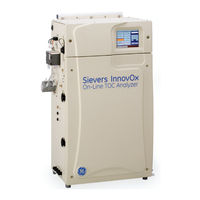GE Sievers Innovox Manuals
Manuals and User Guides for GE Sievers Innovox. We have 1 GE Sievers Innovox manual available for free PDF download: Operation And Maintenance Manual
GE Sievers Innovox Operation And Maintenance Manual (270 pages)
TOC analyzer
Brand: GE
|
Category: Analytical Instruments
|
Size: 14 MB
Table of Contents
Advertisement
Advertisement
